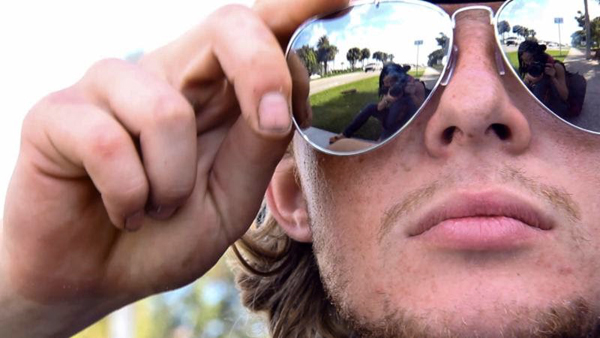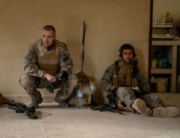![]() This intimate documentary has a potent, us-against-the-world vibe at first, as filmmaker Nanfu Wang hits the streets with a charismatic stranger. Her spirit of adventure brings her to Florida, where at a hostel, she meets Dylan, who is tall, blond, and tattooed and has a friendly demeanor. A free spirit, he lives by his wits alone, and in one of the earliest shots of him, he chops wood with an axe, which he does in exchange for shelter. A physical presence from the get-go, Dylan goes about this task fearlessly.
This intimate documentary has a potent, us-against-the-world vibe at first, as filmmaker Nanfu Wang hits the streets with a charismatic stranger. Her spirit of adventure brings her to Florida, where at a hostel, she meets Dylan, who is tall, blond, and tattooed and has a friendly demeanor. A free spirit, he lives by his wits alone, and in one of the earliest shots of him, he chops wood with an axe, which he does in exchange for shelter. A physical presence from the get-go, Dylan goes about this task fearlessly.
Yet there’s also something calming about the young man’s attitude. When Wang asks about the challenges of being perpetually homeless, he responds, self-assuredly, that it’s the easiest life anyone can imagine. Intrigued, she follows Dylan for the next month, existing on the margins of Florida with him. When strangers ask why he’s doesn’t have a home, a job, any money, etc., he explains that this is his choice. His goal is to see as much of the world as he can, existing unfettered, at least while he’s still young. Dylan comes across as a rebel and a dreamer, which clearly has some appeal as he and Wang are constantly offered shelter, food, or a little cash.
This first third of the film is an exploration of life on the streets, and part of what makes it seem immediate and exhilarating is the director’s decision to live it herself. She hands the camera to Dylan to record her, such as when she eats food out of the garbage for the first time. At the same time, Wang manages to capture the infectious vibe of living life on no one else’s terms but hers. For example, there is a cheeky sense of excitement when she and Dylan pose as a couple interested in buying a time share, for which they receive 50 dollars for taking a tour.
Still, the film doesn’t shy away from potential hazards. One of the more suspenseful scenes occurs after they trespass into a park after dark and are awoken in the middle of the night by police sirens, which terrify Wang. They also encounter the occasional condescending person who accuses Dylan of taking the “easy way out.” This sort of run-in takes place at a church social, which is the type of event Dylan seems inexplicably drawn to. His upset feelings afterwards are the first hint that his interior life may not be as tranquil as first thought.
The middle section takes place years after they parted ways, as Wang is in the process of filming what would become her much-acclaimed first documentary, Hooligan Sparrow. Finding herself in Utah, Dylan’s home state, she looks up his family and delves into his backstory further. Up until now, our perception of him has largely been as a free spirit. However, there are troubling revelations as to just how “free” he really is or whether factors such as severe mental illness and drug addiction compelled him. As it happens, Dylan’s father is getting remarried, bringing an opportunity for Dylan and Wang to get reacquainted, and for her and viewers to see him in a new and different light.
With Hooligan Sparrow, Wang proved herself a documentarian of great empathy, sticking up for a women’s rights activist in the face of persecution by the Chinese government. Here she questions whether, for all his talk of choice, Dylan’s self-determination might have been a false front. She invites viewers to look closer, and a recurring motif during the latter half is the recycling of previously-viewed footage, which given new information at hand, plays very differently the second time around. As it turns out, during moments in which Dylan might seem at his most independent, he is actually at his most boxed-in mentally.
Ultimately, I Am Another You is a thoughtful meditation on how an individual’s inner and outer selves can differ profoundly, and how we can be acquainted with somebody for years but not really know them at all. It’s also a call for greater understanding toward those with mental disorders, especially those who aren’t like Dylan, who can still get by with some bravado and a smile.

















Leave A Comment